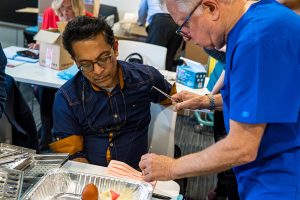The right skills in complex situations
Featured Products Promotional FeaturesPosted by: Dental Design 29th December 2023

Innovation continues to transform the dental landscape: processes are becoming more streamlined, treatment quicker and less intensive for patients; and opportunities for skills progression more abundant than ever before. Despite such momentous advancements, there are many risks that could still present during treatment, namely the biological complications that can interfere and potentially compromise the final outcome. With patient expectation and demand so potent in this digital age, alongside the growing needs of an aging population, clinicians and their teams must be prepared to tackle ever-more complex cases. As such, it is essential to remain abreast of skill acquisition and development, which provides a myriad of benefits to your patients, your career and your standards as a professional.
The biological problem in implant dentistry
A lot of status is placed on a person’s visual appearance, and trends in the dental market are often driven by said status: as a result, the dental market has become rife with options to improve the aesthetics of one’s smile. Interest in treatments like dental implants has seen impressive grown; simultaneously, so have opportunities for clinicians to refresh their skillsets and improve the care they deliver. This is not only imperative for delivering safe and ethical dentistry, but it also allows professionals to expand their clinical capabilities and, by extension, their confidence when tackling more complex cases.
An expansive skillset enables clinicians to provide more options for patients, which in turn also makes it easier to ascertain the most appropriate course of action – especially when complications present during treatment. In dental implantology, bone resorption is a common issue, occurring largely in the first 3 months following a tooth extraction, according to studies.[i] As you know, bone resorption, especially in patients with more complex needs, drastically compromises the rehabilitation pathway.[ii] Depending on other biological considerations, such as patient age and overall health, there may be several potential options that clinicians will need to deliberate. For instance, certain surgical techniques may be indicated, such as bone grafting or sinus lifting; if suitable, newer techniques like zygomatic implant surgery can be implemented, as this modality shows positive success rates in those with severe maxillary atrophy.[iii]
Having a wider range of skills allows you to avoid referring patients elsewhere if the case falls outside of your remit. You can build a more comprehensive patient base, utilising your knowledge to tackle the more complex cases and provide successful, long-lasting outcomes to a wider range of patients.
Taking your skills to a new level
The literature supports the view that a strong sense of confidence is integral to personal development, one’s ongoing study and improved competence.[iv] When it comes to skill and knowledge acquisition, the more you invest in  your training over time, the wider the playing field in which to you can determine the best course of action for each patient. Patients value trust, and demonstrating your excellence is a potent way to earn and sustain that trust.[v] Being able to plan treatment well, communicate effectively and engage the patient encourages a more proactive relationship, helping to manage patient expectations and improve patient compliance throughout and long after surgery.[vi]
your training over time, the wider the playing field in which to you can determine the best course of action for each patient. Patients value trust, and demonstrating your excellence is a potent way to earn and sustain that trust.[v] Being able to plan treatment well, communicate effectively and engage the patient encourages a more proactive relationship, helping to manage patient expectations and improve patient compliance throughout and long after surgery.[vi]
Skill acquisition is more than simply adding new techniques and modalities to your dental repertoire: it is about providing a higher level of care, bolstered by clinical confidence, competence and the ability to offer more in your practice. As such, it is vital to choose a training pathway that provides you with only the best resources, including guidance from professionals who will help you gain comprehensive knowledge that is immediately applicable in practice. If you are an experienced implant dentist, you need to invest in a training programme that is tailored enriching and building on your existing skills. If you are seeking a comprehensive, carefully curated course, consider the Advanced Certificate course in Bone and Tissue Regeneration and Sinus Grafting, a blended University Certificate course delivered in 5 parts over 5 months including 2 days of hands-on workshop and 2 intensive days of 2-day cadaveric surgical training programme. Headed by a faculty of expert ENT consultants, under the eminent Specialist Oral Surgeon Professor Cemal Ucer’s lead, you can take your abilities further with this unique learning opportunity. The syllabus covers a variety of pertinent topics, from block bone grafting, zygomatic and pterygoid implant options, 3D diagnostic imagining and much more.
Keep going, keep growing
Dentistry is constantly adapting to changing demands and expectations. With an aging population and the social media phenomenon shaping what is required from the dental team, skill development is an absolute necessity. Making prime decisions as to where and with whom you train means you can flourish in a way that best suits you and your current skill level. You can take what you’ve learnt and go much further: to the benefit of your patients and your own clinical abilities.
To find out more, contact Ucer Education today. Contact Professor Ucer at ucer@icedental.institute or Mel Hay at
mel@mdic.co; call 01612 371842 or visit www.ucer-clinic.dental.
Professor Cemal Ucer (BDS, MSc, PhD, Oral Surgeon, ITI Fellow)
[i] Ebenezer, S., Kumar, V.V. and Thor, A. (2021). Basics of Dental Implantology for the Oral Surgeon. Oral and Maxillofacial Surgery for the Clinician, [online] pp.385–405. Available at: https://link.springer.com/chapter/10.1007/978-981-15-1346-6_18[Accessed 31 Aug. 2023].
[ii] Marko Igić, Milena Kostić, Pejcic, A., Nikola Gligorijević, Marija Jovanović and Nenad Stošić (2023). Overview of the possibility of bone replacement for the purpose of pre-prosthetic preparation of the patient. Acta Facultatis Medicae Naissensis, [online] 40(1), pp.22–27. Available at: https://scindeks-clanci.ceon.rs/data/pdf/0351-6083/2023/0351-60832301022I.pdf [Accessed 31 Aug. 2023].
[iii] Solà Pérez, A., Pastorino, D., Aparicio, C., Pegueroles Neyra, M., Khan, R.S., Wright, S. and Ucer, C. (2022). Success Rates of Zygomatic Implants for the Rehabilitation of Severely Atrophic Maxilla: A Systematic Review. Dentistry Journal, [online] 10(8), p.151. Available at: https://www.mdpi.com/2304-6767/10/8/151/htm [Accessed 31 Aug. 2023].
[iv] Fine, P., Leung, A., Bentall, C. and Louca, C. (2019). The impact of confidence on clinical dental practice. European Journal of Dental Education, [online] 23(2), pp.159–167. Available at: https://pubmed.ncbi.nlm.nih.gov/30585682/ [Accessed 31 Aug. 2023].
[v] Newsome, P., Smales, R. and Yip, K. (2012). Oral diagnosis and treatment planning: part 1. Introduction. British Dental Journal, [online] 213(1), pp.15–19. Available at: https://www.nature.com/articles/sj.bdj.2012.559 [Accessed 31 Aug. 2023].
[vi] Cortellini, S., Favril, C., De Nutte, M., Teughels, W. and Quirynen, M. (2019). Patient compliance as a risk factor for the outcome of implant treatment. Periodontology 2000, [online] 81(1), pp.209–225. Available at: https://onlinelibrary.wiley.com/doi/abs/10.1111/prd.12293 [Accessed 31 Aug. 2023].










